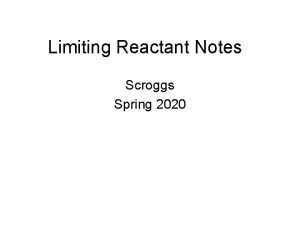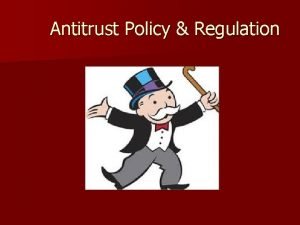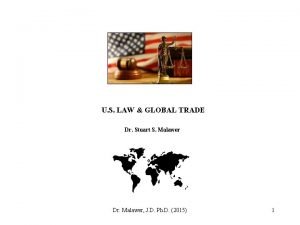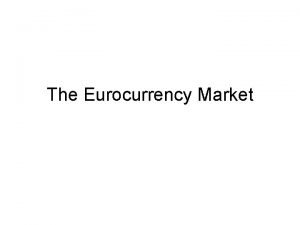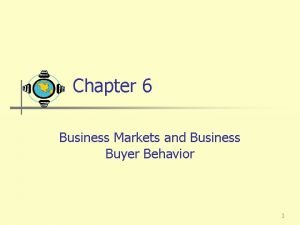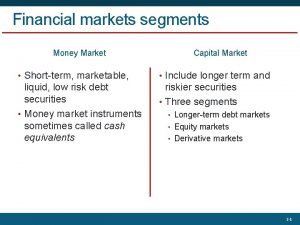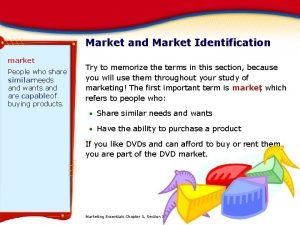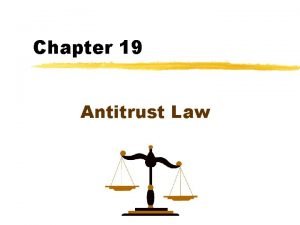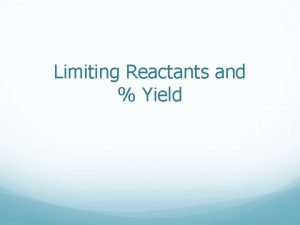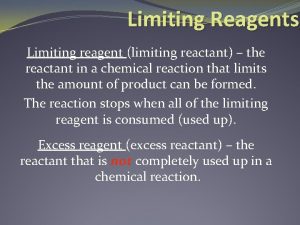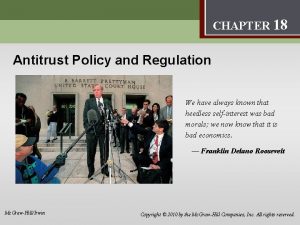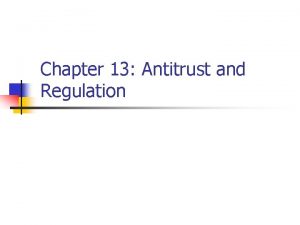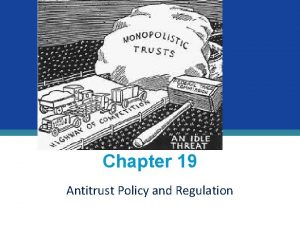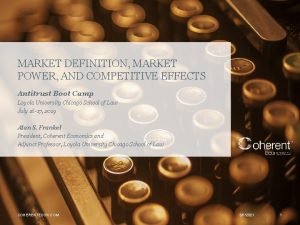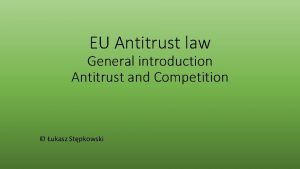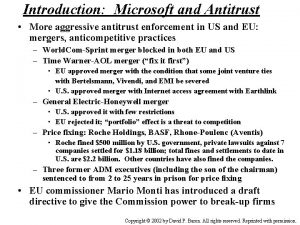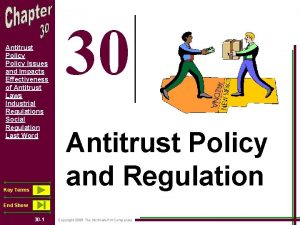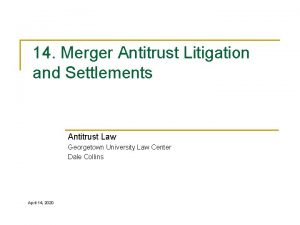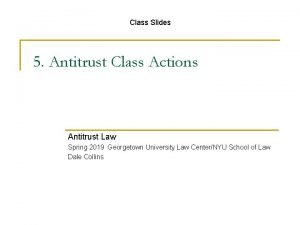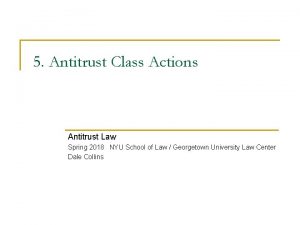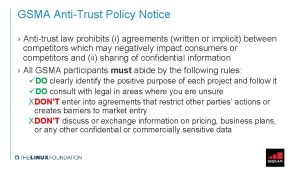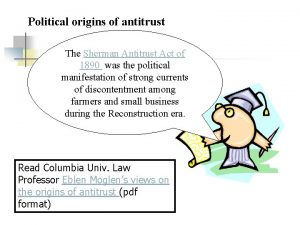18 Limiting Market Power Regulation and Antitrust The


















































- Slides: 50

18 Limiting Market Power: Regulation and Antitrust. . . The one law you can’t repeal is supply and demand. WILLIAM SAFIRE, NEW YORK TIMES, JULY 13, 1998

Contents ● The Public Interest Issue: Monopoly Power Versus Mere Size ● Part 1: Regulation ♦ What is Regulation and Who Regulates What? ♦ Some Objectives of Regulation ♦ Two Key Issues That Face Regulators ♦ The Pros and Cons of “Bigness” ♦ Deregulation Copyright © 2003 South-Western/Thomson Learning. All rights reserved.

Contents (continued) ● Part 2: Anti-Trust Laws and Policies ♦ The Public Image of Business When Anti-Trust Laws Were Born ♦ Measuring Market Power: Concentration ♦ A Crucial Problem for Anti-Trust ♦ Mergers and Competition ♦ Use of Antitrust Laws to Prevent Competition Copyright © 2003 South-Western/Thomson Learning. All rights reserved.

Part I: Regulation

The Public Interest Issue: Monopoly Vs Mere Size ● Firms that possess monopoly power may threaten the public interest. ● The abuse of monopoly power is undesirable because: ♦ High prices reduce the wealth of consumers. ♦ High prices lead to resource misallocation. ♦ Efficiency and innovation may be stifled. Copyright© 2003 Southwestern/Thomson Learning. All rights reserved.

The Public Interest Issue: Monopoly Vs Mere Size ● But firms that are big do not necessarily have power Howmarket and Why Did Regulation Arise? ♦ oligopoly market ♦ easy entry Copyright© 2003 Southwestern/Thomson Learning. All rights reserved.

What Is Regulation and Who Regulates What? ● Regulation: government agencies that enforce rules about business conduct enacted by Congress ● Types of government regulation of industry ♦ Limiting market power ♦ Promoting consumer and worker protection and safety Copyright© 2003 Southwestern/Thomson Learning. All rights reserved.

What Is Regulation and Who Regulates What? ● Federal Communications Commission: broadcasting and telecommunications ● Federal Energy Regulatory Commission: interstate transmission of electric power and sale of natural gas ● Securities and Trade Commission: sales of securities ● Federal Reserve System: banking Copyright© 2003 Southwestern/Thomson Learning. All rights reserved.

Some Objectives of Regulation ● Control of market power resulting from economies of scale and scope ● The pricing of “bottleneck” facilities and the parity-pricing principle ● Universal service and rate averaging Copyright© 2003 Southwestern/Thomson Learning. All rights reserved.

Price and Cost per Unit FIGURE 18 -1 Economies of Scale $7 B A 5 P AC 3 MC 0 50 100 Quantity Produced per Year Copyright © 2003 South-Western/Thomson Learning. All rights reserved.

Two Key Issues That Face Regulators ● Prices intended to promote the public interest may cause financial problems for firms. ● How to prevent firms with monopoly power from earning excessive profits without eliminating all incentives for efficiency and innovation Copyright© 2003 Southwestern/Thomson Learning. All rights reserved.

Two Key Issues That Face Regulators ● Marginal versus Average Cost Pricing ● In many regulated industries, firms would go bankrupt if P = MC because: ♦ Many exhibit significant economies of scale. ♦ In industry with economies of scale, long-run average cost curve is downward sloping. ♦ If average cost is declining, marginal cost must be below average cost. Copyright© 2003 Southwestern/Thomson Learning. All rights reserved.

Two Key Issues That Face Regulators ● Marginal versus Average Cost Pricing ♦ Setting price equal to average cost is also problematic, especially for a multi-product firm. ♦ The Ramsay pricing rule is a regulatory solution. Copyright© 2003 Southwestern/Thomson Learning. All rights reserved.

Two Key Issues That Face Regulators ● Preventing Monopoly Profit but Keeping Incentives for Efficiency and Innovation ♦ When regulators control profits, they face the danger of removing the useful incentive effects of profits. ♦ The existence of regulatory lag may offer some incentive for efficiency. Copyright© 2003 Southwestern/Thomson Learning. All rights reserved.

Two Key Issues That Face Regulators ● Price Caps as Incentives for Efficiency ♦ An adjusting price cap is a way of controlling profits yet retaining some of the incentive effects of profits. Copyright© 2003 Southwestern/Thomson Learning. All rights reserved.

The Pros and Cons of “Bigness” ● Bigness in industry may benefit the general public: ♦ Economies of large size: where small-scale operation is inefficient ♦ Required scale for innovation Copyright© 2003 Southwestern/Thomson Learning. All rights reserved.

Deregulation ● Effects of Deregulation ♦ Effects on prices: generally lower prices ♦ Effects on local services: some communities have been hurt, some have gained ♦ Effects on entry: many new competitors Copyright© 2003 Southwestern/Thomson Learning. All rights reserved.

Deregulation ● Effects of Deregulation ♦ Effects on unions: unions have been hurt ♦ Effects on concentration and mergers: many mergers following deregulation ♦ Effects on product quality: “no frills” services have become common Copyright© 2003 Southwestern/Thomson Learning. All rights reserved.

Deregulation ● Effects of Deregulation ♦ Effects on safety: no change ♦ Effects on profits and wages: profits and wages have been depressed ♦ Conclusion: Deregulation has helped some and hurt others, but, in general, it has promoted the welfare of consumers. Copyright© 2003 Southwestern/Thomson Learning. All rights reserved.

18 -2 A “Hub and Spoke” Airline Routing Pattern FIGURE E F A H B D C Copyright © 2003 South-Western/Thomson Learning. All rights reserved.

18 -3 U. S. Airline Accident Rates, 1960 -2000 FIGURE 2. 0 Rate per 100, 000 Depar tures 1. 8 1. 6 1. 4 All Accidents 1. 2 1. 0 0. 8 Deregulation (1978) 0. 6 0. 4 Fatal Accidents 0. 2 0 1965 1970 1975 1980 1985 1990 1995 2000 Copyright © 2003 South-Western/Thomson Learning. All rights reserved.

Part 2: Antitrust Laws and Policies

The Antitrust Laws ● The Sherman Act (1890) ● The Clayton Act (1914) ● The Federal Trade Commission Act (1914) ● The Robinson-Patman Act (1936) ● Celler-Kefauver Antimerger Act (1950) Copyright© 2003 Southwestern/Thomson Learning. All rights reserved.

TABLE 18 -1 Basic Antitrust Laws Copyright © 2003 South-Western/Thomson Learning. All rights reserved.

The Antitrust Laws ● The Sherman Act ♦ “Per Se” Issues: courts have consistently held that price fixing among competitors is illegal Copyright© 2003 Southwestern/Thomson Learning. All rights reserved.

The Antitrust Laws ● The Sherman Act ♦ Rule of Reason: Courts have developed different and varying standards for deciding when large companies have illegally: ■ Monopolized trade ■Engaged in tacit collusion ■Used predatory pricing ♦ According to the “rule of reason, ” size alone is not an offense. Copyright© 2003 Southwestern/Thomson Learning. All rights reserved.

The Antitrust Laws ● The Clayton Act ♦ Prohibited price discrimination in restraint of trade ♦ Prohibited tying contracts ♦ Prohibited stock purchases that reduced independence ♦ Prohibited interlocking directorates Copyright© 2003 Southwestern/Thomson Learning. All rights reserved.

The Antitrust Laws ● The Federal Trade Commission Act ♦ The FTC was created to investigate “unfair” and “predatory” competitive practices. ♦ In 1938, the FTC was also charged with preventing false and deceptive advertising. Copyright© 2003 Southwestern/Thomson Learning. All rights reserved.

The Antitrust Laws ● The Robinson-Patman Act ♦ Sought to protect small wholesale and retail firms from the “unfair competition” of chain stores and mass distributors Copyright© 2003 Southwestern/Thomson Learning. All rights reserved.

Measuring Market Power: Concentration ● Concentration: Definition and Measurement —The Herfindahl-Hirschman Index ♦ Four-firm concentration ratio ■% of industry’s output produced by four largest firms ■ a common, but flawed, measure of concentration. Copyright© 2003 Southwestern/Thomson Learning. All rights reserved.

Measuring Market Power: Concentration ● Concentration: Definition and Measurement —The Herfindahl-Hirschman Index ♦ The Herfindahl-Hirschman Index is a more accurate measure of industry concentration and is used by the Department of Justice in analyzing potential mergers. Copyright© 2003 Southwestern/Thomson Learning. All rights reserved.

18 -2 Concentration Ratios and H-H Indexes TABLE Copyright © 2003 South-Western/Thomson Learning. All rights reserved.

Measuring Market Power: Concentration ● Concentration: Definition and Measurement ♦ Three conclusions are widely accepted: ■If an industry has a very low concentration ratio, then its firms are very unlikely to have any market power either before or after the rise in concentration. ■If circumstances in the industry are favorable for successful price collusion, a rise in concentration will facilitate market power. Copyright© 2003 Southwestern/Thomson Learning. All rights reserved.

Measuring Market Power: Concentration ● Concentration: Definition and Measure ♦ Three conclusions are widely accepted (cont’d): ■Where the market is highly contestable, market power will not be enhanced because an excessive price will attract new entrants who will soon force the price down. Copyright© 2003 Southwestern/Thomson Learning. All rights reserved.

Measuring Market Power: Concentration ● Evidence on Concentration in Reality ♦ The concentration of industry has not increased in the United States in the twentieth century. Copyright© 2003 Southwestern/Thomson Learning. All rights reserved.

18 -3 The Trend in Concentration in Manufacturing TABLE Copyright © 2003 South-Western/Thomson Learning. All rights reserved.

A Crucial Problem for Antitrust ● It is often a challenge for the antitrust authorities to distinguish between vigorous competition and acts that undermine competition and support monopoly power. Copyright© 2003 Southwestern/Thomson Learning. All rights reserved.

Anti-Competitive Practices and Antitrust ● Predatory pricing = pricing that threatens to keep a competitor out of the market ♦ One principle widely followed by the courts holds that prices are predatory only if they are below either marginal or average variable costs. Copyright© 2003 Southwestern/Thomson Learning. All rights reserved.

Anti-Competitive Practices and Antitrust ● Even in cases where prices are below MC or AVC, predatory only under two conditions: ♦ If evidence that the low price would have been profitable only if it succeeded in destroying a rival or in keeping it out of the market. ♦ If a real probability that the allegedly predatory firm could raise prices to monopoly levels after the rival was driven out. Copyright© 2003 Southwestern/Thomson Learning. All rights reserved.

Anti-Competitive Practices and Antitrust ● There have been many predatory pricing cases, but few convictions. Copyright© 2003 Southwestern/Thomson Learning. All rights reserved.

Microsoft: Bottlenecks, Bundling, & Network Extern. ● Bottlenecks ♦ MS Windows, an operating system that runs about 90 percent of all personal computers, is a prime example of a bottleneck. ■Microsoft itself supplies not only Windows, but also many applications. ♦ The worry is that Microsoft will use Windows in a way that favors its own programs and handicaps competing programs. Copyright© 2003 Southwestern/Thomson Learning. All rights reserved.

Microsoft: Bottlenecks, Bundling, & Network Extern. ● Bundling ♦ Computer manufacturers receive a discount if they buy a bundle of Microsoft programs, not just Windows alone. ■This means that rival producers of applications have a price disadvantage in selling their products to PC owners. ♦ The question: is Microsoft’s low bundle price legitimate or constitutes a case of predatory pricing to destroy competitors. Copyright© 2003 Southwestern/Thomson Learning. All rights reserved.

Mergers and Competition ● Horizontal Mergers ♦ The merging firms compete directly by supplying products that are identical or very similar ♦ Reviewed by both the Department of Justice and the Federal Trade Commission to prevent mergers that would reduce competition Copyright© 2003 Southwestern/Thomson Learning. All rights reserved.

Mergers and Competition ● Recent Surges in Merger Activity ♦ Since the early 1980 s, more permissive merger guidelines have lead to a significant increase in merger activity that continues today. Copyright© 2003 Southwestern/Thomson Learning. All rights reserved.

Mergers and Competition ● Are Mergers Anti-Competitive? ♦ Mergers sometimes reduce competition, particularly in markets that are not contestable. ♦ However, where there is reason to believe that mergers will not reduce competition, mergers may lead to greater efficiency. Copyright© 2003 Southwestern/Thomson Learning. All rights reserved.

Mergers and Competition ● Do Mergers Improve Performance? ♦ The evidence here is mixed. ♦ Several mergers have been disappointing and brought limited cost savings. ♦ Still, a number of recent studies of merger activity during the 1980 s has reported significant productivity. Copyright© 2003 Southwestern/Thomson Learning. All rights reserved.

Use of Antitrust Laws to Prevent Competition ● A serious concern is the potential misuse of the antitrust laws to prevent competition. ● Firms that try to protect themselves in this way always claim that their rivals have not achieved success through superior ability but, rather, by means that they call “monopolization. ” Copyright© 2003 Southwestern/Thomson Learning. All rights reserved.

Use of Antitrust Laws to Prevent Competition ● Various steps have been suggested to deal with the misuse of U. S. antitrust laws: ♦ Implementation of a “loser pays the legal costs” rule ♦ Prescreening of suits by a government agency Copyright© 2003 Southwestern/Thomson Learning. All rights reserved.

Use of Antitrust Laws to Prevent Competition ● Anything that restricts anti-competitive, private antitrust suits will almost certainly also inhibit legitimate attempts by individual firms to defend themselves from genuine acts of monopolization by rival enterprises. Copyright© 2003 Southwestern/Thomson Learning. All rights reserved.

Concluding Observations ● Most economists believe that by the 1970 s government intervention had clearly gone too far in some respects and that deregulation was, thus, in the public interest. ● However, the general issue is still open to considerable debate. Copyright© 2003 Southwestern/Thomson Learning. All rights reserved.
 Limiting reagent vs limiting reactant
Limiting reagent vs limiting reactant Clayton antitrust act
Clayton antitrust act Antitrust laws
Antitrust laws Antitrust laws
Antitrust laws Requirements for effective segmentation
Requirements for effective segmentation Market leader challenger follower nicher examples
Market leader challenger follower nicher examples Example of negative externality
Example of negative externality Active power reactive power apparent power
Active power reactive power apparent power Euro currency definition
Euro currency definition Primary target market and secondary target market
Primary target market and secondary target market Business markets and business buyer behavior
Business markets and business buyer behavior Bond equivalent yield formula
Bond equivalent yield formula Market identification
Market identification What is ipo
What is ipo Money market and capital market
Money market and capital market Hình ảnh bộ gõ cơ thể búng tay
Hình ảnh bộ gõ cơ thể búng tay Ng-html
Ng-html Bổ thể
Bổ thể Tỉ lệ cơ thể trẻ em
Tỉ lệ cơ thể trẻ em Chó sói
Chó sói Tư thế worm breton là gì
Tư thế worm breton là gì Chúa sống lại
Chúa sống lại Kể tên các môn thể thao
Kể tên các môn thể thao Thế nào là hệ số cao nhất
Thế nào là hệ số cao nhất Các châu lục và đại dương trên thế giới
Các châu lục và đại dương trên thế giới Công thức tính thế năng
Công thức tính thế năng Trời xanh đây là của chúng ta thể thơ
Trời xanh đây là của chúng ta thể thơ Mật thư tọa độ 5x5
Mật thư tọa độ 5x5 Làm thế nào để 102-1=99
Làm thế nào để 102-1=99 Phản ứng thế ankan
Phản ứng thế ankan Các châu lục và đại dương trên thế giới
Các châu lục và đại dương trên thế giới Thơ thất ngôn tứ tuyệt đường luật
Thơ thất ngôn tứ tuyệt đường luật Quá trình desamine hóa có thể tạo ra
Quá trình desamine hóa có thể tạo ra Một số thể thơ truyền thống
Một số thể thơ truyền thống Cái miệng nó xinh thế chỉ nói điều hay thôi
Cái miệng nó xinh thế chỉ nói điều hay thôi Vẽ hình chiếu vuông góc của vật thể sau
Vẽ hình chiếu vuông góc của vật thể sau Biện pháp chống mỏi cơ
Biện pháp chống mỏi cơ đặc điểm cơ thể của người tối cổ
đặc điểm cơ thể của người tối cổ Thế nào là giọng cùng tên
Thế nào là giọng cùng tên Vẽ hình chiếu đứng bằng cạnh của vật thể
Vẽ hình chiếu đứng bằng cạnh của vật thể Phối cảnh
Phối cảnh Thẻ vin
Thẻ vin đại từ thay thế
đại từ thay thế điện thế nghỉ
điện thế nghỉ Tư thế ngồi viết
Tư thế ngồi viết Diễn thế sinh thái là
Diễn thế sinh thái là Dot
Dot Số nguyên là gì
Số nguyên là gì Tư thế ngồi viết
Tư thế ngồi viết Lời thề hippocrates
Lời thề hippocrates Thiếu nhi thế giới liên hoan
Thiếu nhi thế giới liên hoan
